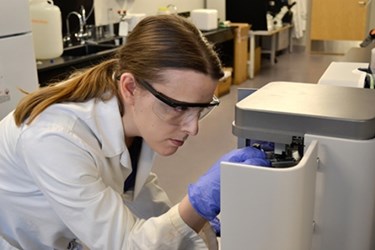3D Printed, Point-of-Care Device Diagnoses Anemia In Seconds

Researchers from Kansas State University (KSU) are developing a 3-D printed device that can diagnose anemia, through a smartphone connection, in just 60 seconds. Because the device is low cost and easy to use, developers believe it could offer point-of-care diagnosis in areas with limited access to medical technology, or at home.
The World Health Organization (WHO) estimates that anemia — a condition resulting from red blood cell deficiency — affects 1.62 billion people worldwide, nearly one quarter of the population, and is most common among preschool-aged children and pregnant women. Though the condition is highly treatable, patients with anemia do not always have access to advanced medical technology.
KSU master's student Kim Plevniak, together with biological engineering professor Mei He, developed a 3D-printed plastic slide, which uses microfluidics to analyze a single drop of blood and send results based on a color scale to a smartphone, reported a KSU press release. Steve Warren, assistant professor in electrical and computer engineering, is collaborating with the research team to develop a smartphone app, which could transmit the results directly to a healthcare provider.
The research team was recently granted permission to test its prototype on samples collected at the University of Kansas Medical Center. Further testing will help researchers refine the device so it can detect anemia at its different levels of severity.
“Anemia is a very prevalent condition in developing countries even though it is easily treated with iron supplements or vitamins and can be prevented with a healthy diet,” Plevniak said. “Often in these developing countries people will have a much easier access to smartphones than they will to doctors and trained medical professionals.”
A 2016 Mobility Report released by Ericsson predicts that global smartphone subscriptions could grow to 9.2 billion by 2020, with the largest spike of growth occurring in emerging markets. According to Ericsson, Asia Pacific, the Middle East, and Africa will account for 80 percent of new smartphone subscriptions in the next five years.
In a recent column, Wayne Maddever, CEO of ChroMedX, told MDO that advances in computer science and development are pushing diagnostics out of the lab and back to point-of-care, for both emerging markets and the growing trend toward at-home care, which is expected to reduce healthcare system costs overall.
Companies like ChroMedX are adapting existing diagnostics and translating proven technologies into point-of-care devices. “We are not trying to invent an entirely new battery of tests,” said Maddever. “We are endeavoring to take what exists and make it mobile and field durable, while still generating accurate readings.”
Korean researchers recently introduced a point-of-care device that could diagnose a heart attack by testing blood samples for troponin. An interdisciplinary team from the University of Alberta is working to adapt glucose meter technology into a point-of-care diagnostic device for the Zika virus.
Early in February, Abbott announced its $5.8 billion acquisition of Alere, a medtech specializing in point-of-care diagnostic technology, a move expected to significantly expand Abbott’s diagnostics foothold in both the U.S. and emerging markets.
